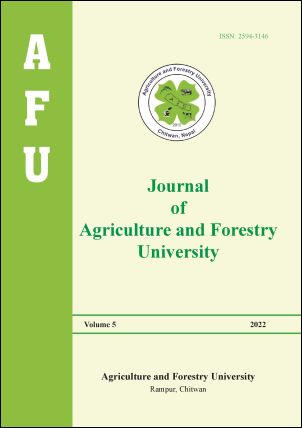Comparative study on fattening performance of different goat breeds supplemented with common fodder trees in mid hills of Nepal
DOI:
https://doi.org/10.3126/jafu.v5i1.48449Keywords:
Dry matter, average daily gain, mixed fodders, short term intake rateAbstract
Goat (Capra hircus) is important meat animal of the country. Fattening performance of different breeds of goats with common mid hill fodder trees was conducted in Completely Randomized Design with 4×5 factorial arrangements at Goat Research Station, Tanahun. The first factor was breed of goats and second factor was species of fodder trees. The main parameters monitored included dry matter (DM) intake, fattening performance and average daily gain (ADG) of goats with respect to different fodders. Results showed that DM intake by breeds of goats and species of fodder trees were highly significant (p<0.001). Weight gain of different breed of goats and species of fodder trees were significantly different (p<0.01) with Boer cross and Listea monopetala having higher weight. The ADG of Boer cross, Jamunapari cross, Khari and Barbari cross were 70.93g, 59.35g, 53.38g and 45.36g, respectively and highly significant (p<0.01). Likewise, ADG of L. monopetala, was higher than other fodder trees. The interaction effects of breeds of goat and fodder species on ADG were similar up to 8 weeks and later observed significantly different (p<0.01). L. monopetala and Ficus lacor were better fodders in terms of fattening performance of different breeds of male goats. From the experiment of blood serum analysis, phosphorus content of F. lacor was significantly higher (p<0.01). Results of subsequent short term intake rate (STIR) measurement in order to find out the preference of fodders trees revealed that significantly higher (p<0.05) intake was obtained for L. monopetala, followed by F. lacor, Ficus glaberrima, Melia azedarach and mixed fodders (0.45g, 0.39g, 0.38g, 0.34g and 0.33g DM min1 per kg metabolic body size), respectively. The results of this study revealed that Boer crosses were more potential for fattening in terms of weight gain and voluntary intake. Likewise, L. monopetala and F. lacor were found better in fattening the male goats compared to other fodders.
Downloads
Downloads
Published
How to Cite
Issue
Section
License
Copyright (c) 2022 Agriculture and Forestry University (AFU), Rampur, Chitwan, Nepal

This work is licensed under a Creative Commons Attribution-NonCommercial 4.0 International License.
This license allows reusers to distribute, remix, adapt, and build upon the material in any medium or format for noncommercial purposes only, and only so long as attribution is given to the creator.




